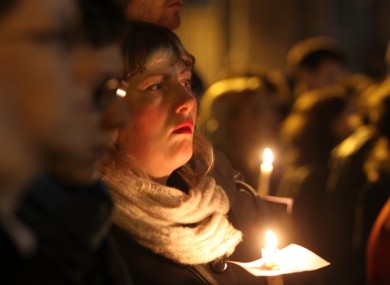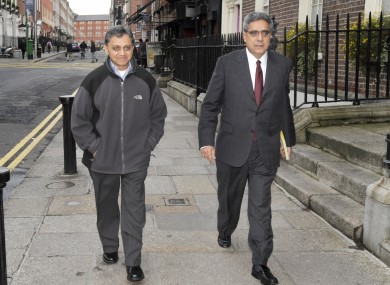British Police investigate case of woman who traveled from Ireland & died after an abortion
A 32 year old woman died hours after a termination procedure in London.
Police in the UK are investigating the case of a woman who traveled from Dublin to London for an abortion but died hours after the procedure had taken place.
The 32-year-old woman, who was a foreign national living in Ireland and underwent an abortion at a Marie Stopes clinic in west London. However, she died in a taxi hours after the procedure.
The woman, who was legally resident in Ireland, had sought an abortion at a maternity hospital in Dublin but had been told that it was not legally possible to provide one in this jurisdiction.
She is understood to have had a condition which raised the risk of miscarriage, although it was not believed to be in any way life-threatening.
The London Metropolitan Police has confirmed it was investigating the circumstances surrounding the case and preparing a file for the Crown Prosecution Services. It declined to comment further.
Marie Stopes yesterday declined to comment on the case on the basis of client-confidentiality.
The woman died in January 2012. An inquest has not yet been held into the woman’s death as the police investigation is continuing.
Anonymous
The woman’s husband, who wishes to remain anonymous, said he is still waiting for answers but is frustrated at the lack of progress.
Anonymous
The woman’s husband, who wishes to remain anonymous, said he is still waiting for answers but is frustrated at the lack of progress.
“I think if this was an Irish or a British woman, we would know what happened to her. But I am still waiting for answers.
He also said he was frustrated at the lack of assistance from some Irish authorities in seeking an abortion for his wife.
He said his wife had a child in Ireland in 2010 but the pregnancy was painful and complicated by extensive fibroids.
The husband said the couple was told that treatment of the condition could involve a procedure that would leave her infertile.
“We were worried about what would happen when she became pregnant again,” he said.
“She was sick, but we were told that nothing could be done in Ireland.”
Twenty weeks pregnant
He said his wife was about 20 weeks pregnant when she travelled to Britain for an abortion. She might have had an abortion sooner, he added, but he and his wife had spent time exploring the various options available to them and raising money for the procedure.
He said his wife was about 20 weeks pregnant when she travelled to Britain for an abortion. She might have had an abortion sooner, he added, but he and his wife had spent time exploring the various options available to them and raising money for the procedure.
“We were left on our own to deal with it. We didn’t get any help at all,” he said.
Both he and his wife were in Ireland on student visas at the time.
He is now 33 years of age and living in Ireland with his three-year-old daughter.
Maternal mortality
The woman’s case is likely to be examined by the UK’s Centre for Maternal and Child Enquiries, an organisation aimed at reducing the incidence of maternal mortality.
The woman’s case is likely to be examined by the UK’s Centre for Maternal and Child Enquiries, an organisation aimed at reducing the incidence of maternal mortality.
Maternal deaths are relatively rare in the UK. A recent report by the centre found that between 2006 and 2008 a total of 261 women in the UK died directly or indirectly related to pregnancy.
The overall maternal mortality rate was 11 per 100,000 maternities.
Thousands of Irish women travel to the UK for abortions every year. Latest figures show that almost 4,000 women from the Republic travelled to England or Wales for an abortion last year.
Former IMF official Ashoka Mody warns austerity could be ‘self-defeating’ for Ireland
Ashoka Mody with the IMF’s Ajai Chopra
Proposed budget cuts should be ‘considerably lowered’, Ashoka Mody urges
A former senior IMF official has warned that austerity must end for the economy to grow while a Labour Party paper has said more welfare cuts “may not be politically deliverable”.
Austerity was a “potentially self-defeating policy” because of the lack of growth and no reduction in debt levels it had resulted in, said former IMF chief of mission to Ireland Ashoka Mody.
“We have to ask ourselves why Ireland is not growing . . . It’s hard for me to believe that austerity is not contributing to this,” he told RTÉ’s This Week.
It had become “orthodoxy that the only way to establish market credibility” was to pursue austerity policies. But five years of crisis and two recent years of no growth needed “deep thinking” on whether this was the right course of action, said Mr Mody.
Asked whether Ireland should implement a €3.1 billion reduction in spending in this year’s budget demanded by the EU-IMF troika he said this figure should be “considerably lowered”. “I would even ask the question why can we not imagine and consider the possibility that for the next three years, as an experiment, there be no further fiscal consolidation,” he added.
“The only instrument left to address this in the short term is the fiscal instrument and that requires complete rethinking of how aggressive and how persistent the austerity has to be,” Mr Mody said.
There was “not one single historical instance” where austerity policies have led to an exit from heavy debt burden. Changing policies could possibly lead to growth, reduce debt levels and also prompt a “psychological boost” for the economy, he added.
Mr Mody said the likelihood of Ireland getting money back form the European Stability Mechanism for its legacy banking debt was “almost zero”. “I would be astonished if it happens,” he added.
During a meeting last week the EU-IMF troika urged the Government to deliver a €3.1 billion cut in budget spending. But some Ministers are resistant to such level of cuts.
A paper circulated among senior Labour Party officials states budget cuts will have to be “lowered considerably”. The level of welfare cuts expected in this October’s budget are “very problematic and politically undeliverable”, theSunday Business Post reported. The cuts would be “regressive from a poverty perspective and have a disproportionate impact on certain cohorts”, the paper added.
Minister for Finance Michael Noonan said last week the Government would not be ending its austerity policy, despite savings made after reform of debt deals.
Dancers set record for largest Riverdance performance on Dublin Quays
DANCE TROUPE FROM 44 COUNTRIES GATHER IN SNAKING LINE ALONG RIVER LIFFEY
Some of the 1,693 Irish dancers including members of the current Riverdance troupe along the banks of the River Liffey during their successfull Guinness World Record attempt for the most number dancers performing Riverdance at the one time. The dancers lined the North and South Quays while also crossing the Samuel Beckett Bridge.
The event shook the capital, literally. Once the opening bars of Bill Whelan’s now world renowned Riverdance song kicked in and the dancers started tapping the Samuel Beckett Bridge began to bounce like a trampoline.
“Dancers need a sprung floor,” Butler said after the event. “And this is the most sprung of a floor I’ve ever danced on.”
Leading the way alongside Butler was Padraic Moyles, a Riverdance member for more than a decade, who said the experience was the highlight of his career.
“There’s no better fit than riverdance and the Gathering,” he said after signing autographs and posing for photos with wide-eyed fans.
“It’s just so fitting that we have the world record here in Dublin, along the banks of the river Liffey, where Riverdance originally started back in 1994,” he said.
“It’s amazing what this small country can do, isn’t it? … Through our poets, our playwrights, our musicians and our dancers we’ve gone to all four corners of the world and we spread a positive message all the time.
“It should be something that we’re all extremely proud of,” he said.
With hands joined together in a circle that ran from the Samuel Beckett Bridge along both banks of the Liffey up to the Sean O’Casey Bridge, members of more than 160 different Irish dance schools throughout the world danced for five minutes straight.
And then they did it all over again ten minutes later, in order to ensure that the old record, of 652 held by Nashville in Tennessee, was officially broken.
While the sun had been shining non-stop all week and temperatures reached 30 degrees in some parts, today it stayed firmly behind the clouds. Riverdance producer, Moya Doherty, was glad temperatertures stayed low by recent standards “so that the dancers [didn’t] have to be picked up off the ground”.
“Just standing on this iconic bridge… and feeling the pulsation of the dancers is extraordinary,” she said. “[I’ve] met people from Russia, Seattle… Australia so it is quite the gathering, it’s very moving.”
Director of Riverdance, John McColgan, said the talent on display was “truly remarkable” and “proof, if we needed it, of the enormous affection that exists for Irish dance and Riverdance”.
Project Director of the Gathering Ireland, Jim Miley, said the event connected people from countries all over the world “in an authentic way that’s deep rooted in Irish culture” and the event was likely to be one of the highlights of the Gathering.
Families from counties throughout Ireland also participated in the event, including the Kilmartins from Laois. “It was brilliant” said 10-year old Ava who said she wasn’t nervous about dancing on the bridge. Conor, her older brother who had been practicing hard during the weeks leading up to the event, said it was “fantastic” to now be a world record holder. 16-year-old Katie, the eldest of the three siblings, said Irish dancing was her passion and the entire experience was “amazing”.
Thousands lined the streets to catch a glimpse of the dancing brilliance on display while dozens more gazed on from boats in the Liffey. It seems that the powerful celtic original which united and delighted audiences 19 years ago hasn’t, in any way, lost its ability to captivate audiences the world over.
Town to be guinea pig in trial to get rid of small change
One and two-cent coins are to be rounded out of Wexford town in a bid to see if consumers will accept getting rid of pesky small change.
But with money tight, one shopkeeper in the town predicted that consumers would be hostile to the move if they saw prices going up as a result.
The Central Bank announced that Wexford will host a one-cent and two-cent rounding trial this autumn to gauge the reaction of consumers and retailers to the change, which it would like to introduce nationwide.
Prices will be rounded off to the nearest five cent at the till.
The rounding will not apply to each individual item purchased; it will only be carried out on the final shopping bill.
Anne Marie Fortune, who manages Pettitt’s Supervalu in the town, predicted that shoppers might be hostile to the move. She said: “People need all their cents in the current climate and a lot are counting out every last one, so it won’t go down well.”
While there would be winners as well as losers from the rounding process, people would be more likely to remember if they lost out, said Ms Fortune, adding: “People are more prone to seeing prices go up than down – that’s just the way it is.”
MONITOR
However, the fact that rounding would only be carried out on the final bill might lessen the impact, Ms Fortune said.
The Central Bank is keen to reduce the use of small coins. They are a nuisance for it to manage as they keep going out of circulation and so more have to be supplied.
The EU is also keen to discourage their use and the trial announced for Wexford is part of the Central Bank’s National Payments Plan for transforming how people spend their money.
The Consumers’ Association of Ireland (CAI) said it had insisted to the Central Bank that only the final bill should be rounded off. It would have been unacceptable if individual prices had been rounded off.
However, consumer watchdogs must monitor prices to ensure retailers do not round them up over time, as happened during the switchover to the euro, said the CAI’s chief executive, Dermott Jewell.
Irish Coast Guard crewman delivers baby boy in Letterkenny
The woman was taken to Letterkenny General Hospital but gave birth to the baby in the corridor with the help of the crew member.
The Irish Coast Guard has said today that one of the crew members on its Rescue 118 helicopter delivered a baby last night.
The crew was tasked with transferring a woman who was in advanced labour from Aranmore to Letterkenny General Hospital.
On its Facebook page, the coast guard said that the helicopter landed at the hospital and two paramedics started to wheel the women to the delivery suite. However she didn’t make it that far and began to give birth in the hospital corridor.
The paramedics left to get the midwife but the coast guard said today that “the baby had other plans”.
Crewman Gary Robertson had helped deliver the baby in the corridor of Letterkenny General Hospital by the time the midwifery team had arrived. The healthy baby boy and mother are both said to be doing fine.
The coast guard said this is the first baby Robertson has ever delivered. And “next time it could be in the back of the helicopter”.
US Aircraft jets drop bombs on Australia’s Great Barrier Reef
US fighter aircraft planes dropped four unarmed bombs on Australia’s Great Barrier Reef in an “emergency jettison” during a training exercise, officials said Sunday, ruling out any risk to the public or environment.
The US 7th Fleet said two Harrier aircraft dropped the ordnance on the iconic reef’s marine park off the Queensland coast on Tuesday.
“The selected emergency jettison area was in a deep channel away from the reef to minimize the possibility of reef damage,” the US 7th Fleet said in a statement.
“It is approximately 50 to 60 metres deep and does not pose a hazard to shipping or navigation.”
An Australian Defence Force spokesman told Australian Associated Press that the bombs posed “minimal risk or threat to the public, the marine environment or civilian shipping transiting the reef area”.
“Defence is working closely with the US military, the Australian government and environmental organisations to ensure there is no danger… now or in the future,” he said.
US and Australian officials are seeking to issue an appropriate navigation notice until charts can be updated showing the location of the unexploded ordnance, the 7th Fleet said.
The two AV-8B Harrier planes had intended to drop the bombs on a range on a nearby island but were unsuccessful despite several attempts.
“After being unable to expend their ordnance during a planning training mission, and having insufficient fuel to reach their pre-designated jettison area, the pilots jettisoned the ordnance in an unarmed condition on July 16,” the 7th fleet said.
The fleet said each Harrier jettisoned one BDU 45, which are inert ordnance, and one GBU 12, which were dropped in an unarmed state.
About 28,000 Australian and US military are involved in training exercise Talisman Saber in Queensland, which began on 15 July and ends on 5 August.











No comments:
Post a Comment